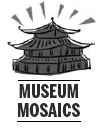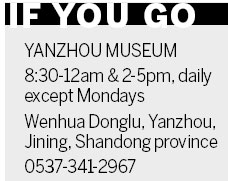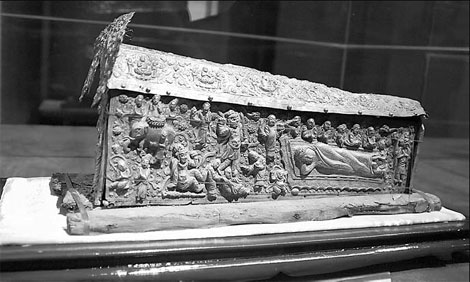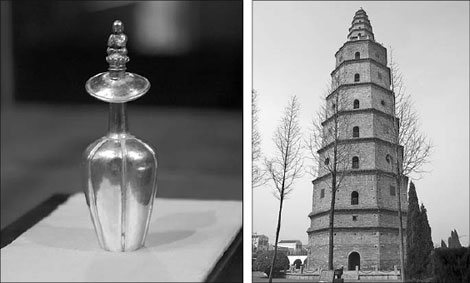Icon of Intellect
Updated: 2012-04-08 07:51
By Han Bingbin(China Daily)
|
|||||||
|
The gilt silver coffin is among the holy relics unearthed under the Xinglong pagoda. Photos provided to China Daily |
|
Left: The gold bottle holds the skull sarira of Sakyamuni. Right: Xinglong pagoda was built in Northern Song Dynasty. Han Bingbin / China Daily |
Despite some scholarly doubts, Yanzhou's fragment of Sakyamuni's skull draws tourists from all over. Han Bingbin reports from Shandong.
The 13-story Xinglong pagoda has looked over Yanzhou city since it was built in the Northern Song Dynasty (960-1127) more than 900 years ago. The six upper floors are much smaller than the lower floors and form a structure that is known as the "tower atop a tower".
It is this architectural detail that makes this particular pagoda unusual among the many found all over the country.
Located in the heart of Yanzhou, East China's Shandong province, the pagoda has also attracted much attention and controversy.

In 2007, a migrant worker named Cui Feng started an unusual project based on his self-taught knowledge on Chinese burial traditions. He believed there were historical treasures beneath the tower, and so he gathered a few accomplices and spent three months secretly digging a tunnel between their rental house and the pagoda.
Their illegal deed led to the shocking discovery of an underground palace, and the loot from the relic robbers, and later discoveries by archeologists, comprised a set of Buddhist relics that have made the city famous.
Among the recovered items were a 0.13-meter-high gold bottle, a small (0.45-meter-long) gilt silver coffin as well as a stele that records the history of the pagoda and the holy relics. These have been rated as first-grade national cultural relics, and are now kept in the Yanzhou Museum.
According to the writing on the stele, the gold bottle held the skull sarira (fragments or relic) of Sakyamuni (the founder of Buddhism). There were 47 grains in total, and these are highly valued as the most valuable Buddhist relics as they symbolize Buddha's intelligence.
The epigraph has it that Xinglong pagoda was originally built to preserve these relics. The skull sarira had been originally brought from India by an eminent Khotan monk, Zheng Guang.
The monk had repeatedly failed to accomplish his dream of building a pagoda for the relic. But one year he traveled to the ancient city of Yanzhou where the sarira was passed down to a local monk called He De, who finally built the Xinglong pagoda for the holy relics.
In ancient China, many temples and pagodas were originally built to worship Buddha's relics, but the remains in this pagoda are among the most coveted.
The Yanzhou city government is now building a Xinglong cultural park, with the aim to make the city a destination for Buddhists from all over the country to worship and pay their respects.
However, although many experts believe the inscription is solid proof that the gold bottle contains actual relics of Sakyamuni, it's technically difficult to tell which of the 47 grains are literally from the Buddha's skull.
And, except for this inscription, no other historical documents mentioned the existence of a Buddha's skull relic at Xinglong pagoda.
Some experts thus take it all with a grain of salt, including Wang Haibo, who was part of the panel researching an iron case found at Nanjing's Bao'en Temple in 2008.

The iron case holds a thousand-year-old miniature pagoda containing the top part of Buddha's skull sarira, and some believe this is the only sarira that has been found in China.
Wang's doubts center on the nature of the skull sarira. According to descriptions in many historical documents, a skull sarira is supposed to a piece of bone rather than relics in grains.
In addition, except for the elaboration of the background of the gold bottle, the stele inscription doesn't mention other holy objects found in the underground palace along with the gold bottle, such as the gilt silver coffin, two relic teeth and a great number of relic "grains" that are contained in a glass bottle.
The inscription has it that these holy objects belonged to Longxing Temple, but there is historical record of Xinglong Temple being called "Longxing".
Since the underground palace was closed in 1063, Wang has said, it is likely to have been broken into many times, as the degree of wear and tear of the bricks in the passageway suggests.
Wang's conclusion was that a lot more research is needed to authenticate these relics.
Despite the controversy, the Yanzhou Museum has made its fame with this precious collection, which is noteworthy for its history alone.
Contact the writer at hanbingbin@chinadaily.com.cn.
(China Daily 04/08/2012 page15)

